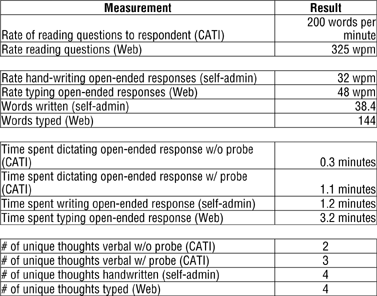The need for speed
Editor's note: Bill MacElroy is president of Socratic Technologies, Inc., a San Francisco research firm.
"Time flies when you're having fun." This popular expression helps to illustrate one of the competitive distinctions for online research. In fact, respondent feedback from recent surveys indicates that the online environment has speed-based advantages and other elements that make a survey seem like less work.
We started several years ago looking at the respondents' perceptions of time needed to participate in surveys. At first, we weren't setting out to study time per se, but rather to understand why people weren't taking part in surveys as much as they used to. They said one of the key reasons was that the (telephone and mail) surveys themselves were boring. Since research and questionnaire design itself hasn't changed much in the past 30 years, the fact that surveys were suddenly becoming more boring and oppressive led us to believe that something must have changed for the respondents. That something seems to be a phenomenon discussed in many popular press articles: time compression.
Time compression is usually described as the feeling that one has more and more to do in a shrinking amount of time. Consumer studies have noted that lack of time is a key barrier that limits the consumption patterns of many products. Things that were never considered to be in the same competitive space are now locked in mortal combat for the time to simply consume a good or service. The same intense competition for a person's time now applies to survey participation as an activity. In short, the "opportunity" to participate in surveys (particularly for free) is becoming a weak competitor for the respondent's free time.
One aspect of online surveys that helps them compete with other pursuits is that online surveys are, in fact, less time-consuming than other types of traditional research methods. An online survey can be 35 percent to 40 percent quicker than a spoken, telephone survey of the identical number of questions. Many people who have been raised within a computing environment now also type up to one-and-a-half times as fast as they can write a sentence or thought of similar complexity. Spelling anxiety (which also tends to slow down handwritten communications) seems to be less worrisome to online typists. (We have seen that this is not true of online chat-type research, in which spelling anxiety tends to produce short, staccato answers that consist of small, easy-to-spell words.)
When online surveying was brand new (five to six years ago) participation rates were huge (50 percent to 60 percent) compared to telephone/mail. Although that rate has dropped (25 percent to 30 percent), it is still many times that of traditional methodologies. Part of the high initial response rates no doubt had to do with the novelty factor that accompanies any new channel of communication. But of course, novelty wears off (until the next new thing); so the drop-off from the initial rates is not surprising. But what keeps the rates so high even after everyone is now doing online surveys? Another element of the puzzle has to do with time selectivity.
When asked, respondents with online capabilities are far more likely to express a preference for online survey participation. A frequently recorded reason for this preference is "because I can do the survey when I want to." For example, many respondents choose to do business-related surveys from home during the evenings and weekends. Similarly, considerable frustration is building toward intrusive contacts, including the use of unsolicited phone surveying. Being able to choose the time of the survey also tips the scale of respondent preference toward the online delivery system. Interestingly, a very good time period for online survey work (versus phone) is over long holiday weekends. (What do you do when you get bored of the family and company? How about doing something online?)
Time perception
The time-related aspects of online surveying have one last element that appears to have even more influence on respondent preference than either the time-compression or time-selectivity advantages: time perception. Getting back to our adage about time flying, the human perception of time tends to vary with the desirability of the activity in which one is engaged (over a reasonable period of time). The more desirable an activity, the shorter the perception of elapsed time of engagement. In this regard, online research wins another round. When using matched surveys of approximately the same length (1999 study), respondents tended to systematically underreport the amount of time needed to complete the online exercise (about 5 percent to 10 percent faster than the actual time taken). Conversely, they tended to overestimate the time needed to complete a phone survey. Open-ended comments related to preference for online included many references to "speed of completion" versus other methods.
And, in fact, time measurement statistics do show a speed gradient ranging from slower spoken surveys (CATI) to typed surveys (Web). The table shows comparable response results for varying methodologies. Note: the measurement groups were taken from various side-by-side studies conducted from 1999 to 2001.
 |
But faster does not always imply better. Are people just skimming questions and instructions on the Web? Do people absorb any more task information when it is read to them versus reading it for themselves? These types of questions need to be answered in a more structured way. In a follow-up article, I will present an in-depth analysis of content and level of sophistication of open-ended questions captured via written-versus-typed input methods.
New and improved
As competing activities vie for the shrinking amount of respondent attention, research will be needed to find new and improved ways of creating a faster, easier, and more engaging interview environment. The Web as a research medium must continue to innovate in order to meet all of these goals in an ever more time-sensitive market. Failing to do so will necessitate paying larger and larger incentives to successfully compete with other, more fulfilling activities.
